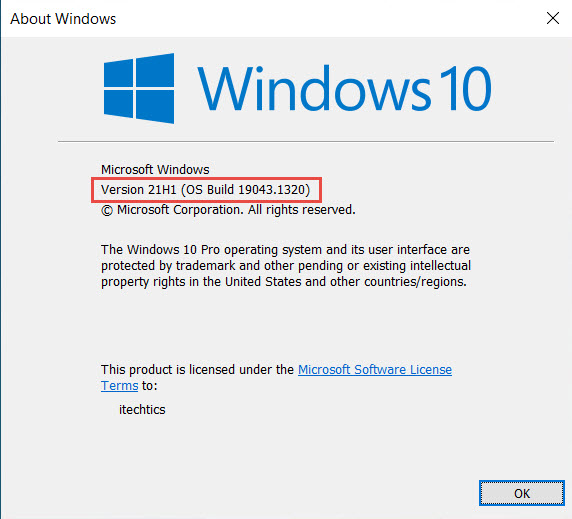This may sound confusing, so we have simplified the Cumulative Update Preview KB5006738 releases for the different versions to make you understand better. KB5006738 is available for the following Windows 10 versions on the 2 different channels:
New Fixes and Improvements Known Issues Download and Install Windows 10 Cumulative Update Preview KB5006738 Offline Installers For Windows 10 Version 21H1 For Windows 10 Version 20H2 For Windows 10 Version 2004 Windows Update Rollback/Uninstall Windows 10 Preview Update Cleanup after Installing Windows Updates
You can check your OS version by typing in winver in Run. Release Preview channel:
Windows 10 v21H2Windows 10 v21H1
Stable channel:
Windows 10 v21H1Windows 10 v20H2Windows 10 v2004
Installing KB5006738 now will upgrade your OS build to 1904x.1320. The purpose of republishing the same KB update is probably because .1320 only provides a minor addition to all the fixes that were included with .1319. If you install KB5006738 on the mentioned versions of Windows 10, it will include all fixes and improvements from .1319, plus an additional one, which is discussed in the next section of this post.
New Fixes and Improvements
As we mentioned, this update includes all the fixes and improvements that were introduced in build 1904x.1319. However, one new fix has been added which made Microsoft republish their last update. Microsoft has fixed an issue that previously prevented a successful installation of printers that used the Internet Printing Protocol (IPP). So anyone experiencing issues with adding a new printer over the network with the last flight can install this build to mitigate the error. But before you do, also consider the known issues with this release highlighted in the next section. KB5006738 also updates the Servicing Stack which helps improve the Windows Update experience for the users, making it more smooth and error-free.
Known Issues
Here is what Microsoft knows so far about what’s wrong with this release: An issue with the standalone (clean) installation of Windows 10 with this update is causing Microsoft Edge Legacy to be removed. However, it is not being replaced by the new Chromium-based Edge. This occurs only when Windows has a custom offline media or an ISO image installed that does not include the 29th March 2021 SSU update. Microsoft suggests that you either install the March SSU update through slipstreaming or simply update an existing OS through Windows Update, so you will not be facing this issue. Alternatively, you can simply download and install the new Microsoft Edge if you have already encountered this problem. Another issue that users might face with this update is that they are unable to install it entirely. This may be because of a previously installed update KB5003690. If that is the case, you can find a workaround for it here in Microsoft’s post. Users may also see an error message “Your credentials did not work. The credentials that were used to connect to (device name) did not work. Please enter new credentials” when connecting to devices in an untrusted domain using Remote Desktop while using smart card authentication. Microsoft has found a temporary fix around the issue which you can find here.
Download and Install Windows 10 Cumulative Update Preview KB5006738
Offline Installers
For Windows 10 Version 21H1
Download KB5006738 for Windows 10 Version 21H1 64-Bit [636.1 MB] Download KB5006738 for Windows 10 Version 21H1 32-Bit [291.8 MB]
For Windows 10 Version 20H2
Download KB5006738 for Windows 10 Version 20H2 64-Bit [636.1 MB] Download KB5006738 for Windows 10 Version 20H2 32-Bit [291.8 MB]
For Windows 10 Version 2004
Download KB5006738 for Windows 10 Version 2004 64-Bit [636.1 MB] Download KB5006738 for Windows 10 Version 2004 32-Bit [291.8 MB] To install the update, simply run the downloaded MSU file and Windows will automatically install the update. To download any other updates related to any of the above, please check the Microsoft Catalog.
Windows Update
To install this update via Windows Update, you need to be running Windows 10 version 21H1, 20H2, or 2004 on the stable channel, or have Windows 10 version 21H2 or 21H1 and subscribed to the Release Preview channel. To check your version of the operating system, type in winver in Run and press Enter. Once the details are confirmed, navigate to the Settings app and then click Windows Update on the left. Then click Check for updates on the right side of the page. Once the scan is finished, you will find the following ready to be downloaded and installed. Click Download and install just below it. Once it is ready, click Restart Now. Once it reboots, you can confirm that KB5006738 has been installed successfully by checking your OS build by typing in winver in Run.
Rollback/Uninstall Windows 10 Preview Update
If you do not wish to keep the installed preview update for some reason, you can always roll back to the previous build of the OS. However, this can only be performed within the next 10 days after installing the new update. To roll back after 10 days, you will need to apply this trick.
Cleanup after Installing Windows Updates
If you want to save space after installing Windows updates, you can run the following commands one after the other in Command Prompt with administrative privileges:


